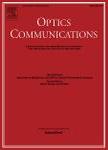版权所有:内蒙古大学图书馆 技术提供:维普资讯• 智图
内蒙古自治区呼和浩特市赛罕区大学西街235号 邮编: 010021

作者机构:Vietnam Acad Sci & Technol Inst Mat Sci 18 Hoang Quoc Viet Hanoi Vietnam Grad Univ Sci & Technol Vietnam Acad Sci & Technol 18 Hoang Quoc Viet Hanoi Vietnam Univ Sci & Technol Hanoi Vietnam Acad Sci & Technol 18 Hoang Quoc Viet Hanoi Vietnam Directorate Stand Metrol & Qual Small & Medium Enterprise Dev & Support Ctr 1 8 Hoang Quoc Viet Hanoi Vietnam
出 版 物:《OPTICS COMMUNICATIONS》 (光学通讯)
年 卷 期:2019年第440卷
页 面:14-20页
核心收录:
学科分类:070207[理学-光学] 07[理学] 08[工学] 0803[工学-光学工程] 0702[理学-物理学]
基 金:Vietnam Academy of Science and Technology (VAST) [VAST03.05/18-19 QTFR01.02/18-19]
主 题:Microsphere Whispering-gallery-mode Lasers Photonic band gap Waveguides
摘 要:Er3+-doped silica glass microspheres (mu S) with diameters of similar to 25-40 mu m were fabricated by using an electrical discharge method. The single-mode optical tapered fibers were used to guide the pumped laser into the mu S surface and collect the resulting lasing emission. The observation of whispering-gallery-mode (WGM) at telecom regime is quantified. With the presented scheme, the selective single-or multi-emitted modes of the mu S laser can be obtained by adjusting the coupling gap between the collection tapered fiber and the mu S surface. To overcome the collection tapered fiber s vibration at close range of the coupling gap, the guiding and coupling losses, while being compact enough to fit with complementary metal oxide semiconductor (CMOS) device, the integration of a mu S with silicon-on-insulator (SOI) slotted photonic crystal waveguides is proposed and modeled with the help of finite-difference time-domain (FDTD) simulations. The designed structures may find application for the promising photonic devices such as the ultrahigh sensitivity sensors, the lasing sources, and towards advanced quantum communications.